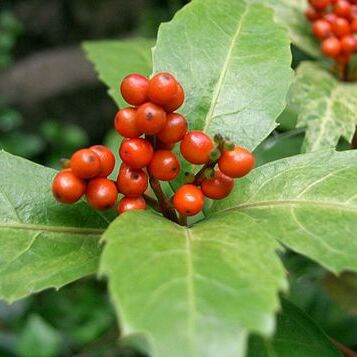Glabrous shrub or half-woody herb, 0.6-3 m tall; stems up to 1.5 cm ø with ± swollen nodes, longitudinally ridged when dry; bark ± smooth. Leaves elliptic-oblanceolate, lanceolate or narrowly elongate-elliptic, 2-20 by 1-8 cm, long-acuminate, cuneate at the base, ± subcoriaceous, coarsely or shallowly very sharply serrate or dentate-serrate, the teeth with thickened points; lateral nerves in 5-10 pairs; stipules small, linear-subulate, c. 1.5 mm long; petiole 0.4-1.7 cm. Inflorescences greenish or ± white, 3-8 cm long, the spikes rather dense, 1-3.5 (-5) cm long; paired bracts 3 mm long; bracteoles oblong, 1 mm long, sometimes ± trifid. Male part 1.3-2 mm long, 1-1.3 mm wide, the anther cells ex-tending from half to the whole length or almost so, c. 1.3 mm long. Female part flask-shaped or subglobose, 1 — 1.5 mm long; stigma up to 1 mm wide. Fruit at first yellow, becoming red or bright orange, very rarely black, 4-7 mm ø (dry), shining. Seed pale, yellowish or cream.
A small shrub 50-150 cm tall. It is half woody. The leaves are simple and opposite. They are 6-13 cm long by 2-5 cm wide. There are teeth along the edge. The flowering shoots are in the axils of leaves and hav scale like leaves. The fruit are bright red. They are 5-6 mm across. There is one seed.

